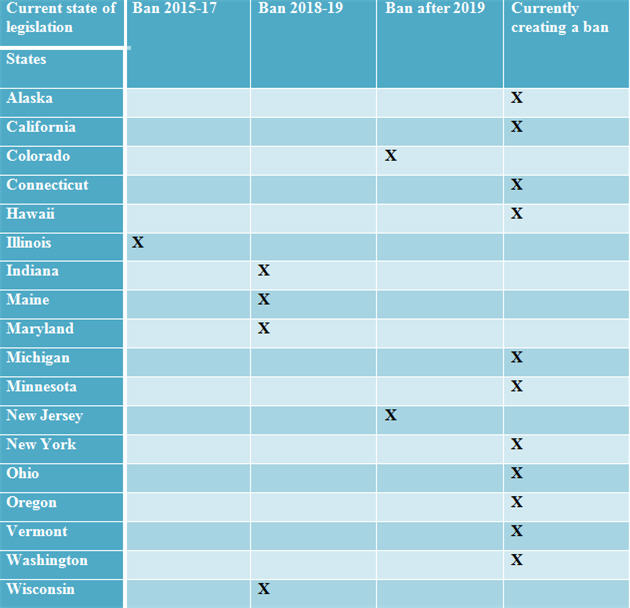Beauty And The Beads
By Marcella Capuco
As a young woman in America, I walk around every day with a target on my back ready to be shot at by marketing campaigns. These jeans will make your legs look skinnier, this toothpaste will make your smile brighter, this mascara will make your eyes pop, and this face wash will give you even, glowing, acne-free skin. Companies know my demographic wants to look flawless, and they know just how to tell me their product will help. When shopping for a face wash, the labels I am drawn to read “acne-fighting” or “oil-free” with the hopes of giving me smooth, beautiful skin. My favorite scrub does just that, but only through being entirely full of tiny, little microbeads. I love what it does for my skin, but at what cost?
What’s the buzz on microbeads?
Microbeads, a form of microplastics, are any plastic pieces or fibers less than five millimeters in size.[i] Although most are the size of sea salt grains, they can range in size from a short grain of rice[ii] to as small as a grain of sand. Microbeads are made of polyethylene (PE), polypropylene (PP), polyethylene terephthalate (PET), polymethyl methacrylate (PMMA), or nylon.[iii] Companies started using microbeads as an economic alternative to natural exfoliants in products such as facial scrubs, cleansers, and toothpastes.[iv] The issues begin once these microplastics are washed down the drain. Microbeads are too small to be effectively removed in U.S. wastewater plants, so they ultimately end up making their way into our local waterways. It has already been reported that filter feeders such as plankton and mussels are retaining microplastics. This is causing a buildup of these microplastics in our food chain, whether we are consuming the filter feeders themselves, or the fish that ate them first. Microplastics such as microbeads have also been proven to attract and absorb persistent organic pollutants (POPs)[v], like DDT (dichlorodiphenyltrichloroethane)[vi], the pesticide responsible for declining the bald eagle population in the 1950s through the 1980s.[vii] Wastewater systems cannot filter POPs out either, so there are hypotheses that these, too, will accumulate in the food chain overtime, just as the microplastics are accumulating now.[viii]
Do we regulate microbeads?
Cosmetics are governed by the Food, Drug, and Cosmetics Act, which requires no review of products before being sold, but rather places the responsibility of consumer safety in the hands of the companies making the products. If customers register a complaint with the U.S. Food and Drug Administration (FDA), then the FDA may look into the safety of the product, but until then, the product cannot be reviewed. As microbeads provide no apparent consumer safety threat while being used, the FDA is not regulating microbeads at this time. The primary threat of microbeads is their fast-approaching impact on our waterways and environment. The U.S. EPA may investigate consumer chemicals under the Toxic Substances Control Act (TSCA), but they will not intervene until there is an “unreasonable risk” to public health or the environment.[ix] Although EPA has recognized microbeads as a pollution threat in the Great Lakes since 2013, they have not yet taken action on regulating future microbead pollution.[x] [xi] [xii]
The best way to stop microbeads from accumulating in our waterways is to discontinue their use. Many states have begun introducing legislation to ban microbeads. Illinois was the first state to pass a bill banning microbeads on June 9, 2014 (effective January 1, 2015) eliminating the sale of personal care products containing microbeads by the end of 2017.[xiii] Table 1 below, “Microbead Savvy States Chart”, includes states which have passed such legislation, in the form of bills and laws, or that are in the process of creating such legislation. As of May 27, 2015, states not included in the table had not introduced legislation on microbeads.
Table 1: Microbead Savvy States Chart

Chart information as of May 27, 2015 [xiv] [xv] [xvi] [xvii] [xviii] [xix] [xx] [xxi] [xxii] [xxiii] [xxiv] [xxv] [xxvi] [xxvii] [xxviii]
How can we stop using microbeads?
Although state bans will decrease the accumulation of microbeads in our waterways, they can only prevent in-state purchases. Unfortunately, people can get around state bans by ordering products containing microbeads online. People use products containing microbeads because they like what those products do for their skin. If I find a product that works for me, I will have no desire to stop buying it until I become aware of something that can outperform what I use. So another way to stop microbeads from rinsing down the drain is to find more effective, environmentally-friendly alternatives and get the manufacturers and the consumers to use them instead. There are many biodegradable alternatives to microbeads, including ground nut shells, salts, sugars, seeds, rice, or bamboo.[xxix] [xxx] Microbeads are typically spherical, whereas natural exfoliants generally have more textured edges with less of a uniform shape. Dr. Bobby Buka, a dermatologist in New York City, NY, points out that this textural difference causes natural exfoliants to provide a better exfoliating quality than microbeads.[xxxi]
Understanding that my face wash is not as effective as one with natural exfoliants is enough to convince me to stop using microbeads. But how do I know what to buy? Many companies have pledged to remove microbeads from their products, and some brands are already microbead-free, including LUSH. Another great way to tell if a product contains microbeads is through the Beat the Microbead app, which scans the barcode of any registered product and tells you instantly whether it contains microbeads. Moving forward, if your favorite brand is not on the list of companies to remove microbeads, or will be phasing microbeads out slowly, you can check to see which individual products of that brand are free of microbeads now.
By being aware of what we are using on our bodies and, more importantly, what we are rinsing down the drain, we can be responsible for preventing further accumulation of microbeads in our local waterways.
About the Author:

Marcella Capuco is a member of the Key School class of 2015 in Annapolis, MD. In the fall of 2015, she will be attending the Pennsylvania State University, College of Engineering studying Civil Engineering. She is participating in a short internship at the Water Environment Research Foundation (WERF), shadowing Lola Olabode, M.P.H., a research program director for the foundation. WERF is currently tracking and monitoring the issues surrounding microbeads and looking for research opportunities to address microbeads and other emerging contaminants.
[i] Microplastics: Scientific evidence. (2014). Retrieved May 26, 2015, from Beat the Microbead website: http://www.beatthemicrobead.org/en/science
[ii] Types of Rice. (n.d.). Retrieved May 28, 2015, from USA Rice Federation website: http://riceinfo.com/all-about-rice/types-of-rice/
[iii] Microplastics: Scientific evidence. (2014). Retrieved May 26, 2015, from Beat the Microbead website: http://www.beatthemicrobead.org/en/science
[iv] Adams, R. (2014, February 20). Why Use Microbeads When The Alternatives Are Better? Retrieved May 27, 2015, from Huff Post Style website: http://www.huffingtonpost.com/2014/02/20/microbeads-exfoliation_n_4815133.html
[v] Microplastics: Scientific evidence. (2014). Retrieved May 26, 2015, from Beat the Microbead website: http://www.beatthemicrobead.org/en/science
[vi] DDT. (1988). Retrieved May 29, 2015, from The Free Dictionary website: http://acronyms.thefreedictionary.com/DDT
[vii] Ehrlich, P. R., Dobkin, D. S., & Wheye, D. (1988). DDT and Birds. Retrieved May 29, 2015, from stanford.edu website: http://web.stanford.edu/group/stanfordbirds/text/essays/DDT_and_Birds.html
[viii] Microplastics: Scientific evidence. (2014). Retrieved May 26, 2015, from Beat the Microbead website: http://www.beatthemicrobead.org/en/science
[ix] Westervelt, A. (2015, April 30). Not so pretty: women apply an average of 168 chemicals every day. the guardian. Retrieved from http://www.theguardian.com/lifeandstyle/2015/apr/30/fda-cosmetics-health-nih-epa-environmental-working-group
[x] Microbeads: All results. (n.d.). Retrieved May 28, 2015, from Environmental Protection Agency website: http://nlquery.epa.gov/epasearch/epasearch?querytext=microbeads&x=0&y=0&fld=&areaname=&typeofsearch=epa&areacontacts=http%3A%2F%2Fwww.epa.gov%2Fepahome%2Fcomments.htm&areasearchurl=&result_template=epafiles_default.xsl&filter=sample4filt.hts
[xi] U.S. United States Environmental Protection Agency. (2014, September). TECHNICAL SUPPORT DOCUMENT TO THE PRELIMINARY ASSESSMENT OF THE FWS – HAWAIIAN ISLANDS NATIONAL WILDLIFE REFUGE: TERN ISLAND SITE IN THE FRENCH FRIGATE SHOALS, HAWAIu02bbI (Weston Solutions, Inc, Author). Retrieved from http://www.epa.gov/region9/mediacenter/tern-island/ternisland-tsd.pdf
[xii] Bigler, J. (2015, September). Tiny plastic beads are latest pollution threat to the Great Lakes. Nation Listing of Fish Advisories. Retrieved from http://water.epa.gov/scitech/swguidance/fishshellfish/fishadvisories/upload/sept2013.pdf
[xiii] S. SB2727, 98th (Ill. 2014). Retrieved from http://www.ilga.gov/legislation/BillStatus.asp?DocTypeID=SB&DocNum=2727&GAID=12&SessionID=85&LegID=78471
[xiv] Ellison, G. (2015, February 25). Michigan joins other Great Lakes states in considering microbead products ban. Retrieved May 27, 2015, from m Live website: http://www.mlive.com/news/index.ssf/2015/02/microbeads_ban_michigan.html
[xv] Associated Press. (2015, January 28). Indiana House committee passes ban on plastic beads polluting lakes. Retrieved May 27, 2015, from WNDU 16 website: http://www.wndu.com/home/headlines/Indiana-House-committee-passes-ban-on-plastic-beads-polluting-lakes-290095491.html
[xvi] Livio, S. K. (2015, March 23). Christie signs bill banning production and sale of environment-harming microbeads. Retrieved May 27, 2015, from nj.com website: http://www.nj.com/politics/index.ssf/2015/03/christie_signs_bill_banning_production_and_sale_of.html
[xvii] Dunbar, E. (2015, May 5). Minnesota Senate bans soaps with plastic microbeads. Retrieved May 27, 2015, from MPR news website: http://www.mprnews.org/story/2015/05/05/microbeads
[xviii] Associated Press. (2015, April 14). Wisconsin Lawmakers Approve Ban on Microbeads. Retrieved May 27, 2015, from WSAW.com website: http://www.wsaw.com/home/headlines/Wisconsin-Lawmakers-Approve-Ban-on-Microbeads-299788611.html
[xix] MICROBEADS BANNED IN COLORADO. (2015, April 2). Retrieved May 27, 2015, from Colorado Legislative Services website: http://www.coloradolegislativeservices.com/microbeads-banned-colorado/
[xx] Maine microbead ban becomes law without LePage signature Tiny plastic particles pollute lakes, rivers. (2015, March 27). Retrieved from WCVB 5 website: http://www.wcvb.com/money/maine-microbead-ban-becomes-law-without-lepage-signature/32045244
[xxi] Environment - Personal Care Products Containing Synthetic Plastic Microbeads - Prohibition on Manufacturing or Sale. (2015, October 1). Retrieved May 27, 2015, from General Assembly of Maryland website: http://mgaleg.maryland.gov/webmga/frmMain.aspx?pid=billpage&stab=01&id=sb0200&tab=subject3&ys=2015RS
[xxii] Nasser, H. E. (2015, May 22). California Assembly votes to ban plastic microbeads. Retrieved May 27, 2015, from Aljazeera America website: http://america.aljazeera.com/articles/2015/5/22/california-assembly-votes-to-ban-plastic-microbeads.html
[xxiii] SHELBY SEBENS. (2015, April 2). Oregon lawmakers consider banning plastic beads in cosmetics. Retrieved May 27, 2015, from reuters website: http://www.reuters.com/article/2015/04/02/us-usa-environment-oregon-idUSKBN0MT2LG20150402
[xxiv] Vermont House votes in favor of microbead ban. (2015, January 27). Retrieved May 27, 2015, from WPTZ.com website: http://www.wptz.com/news/vermont-house-votes-in-favor-of-microbead-ban/30943454
[xxv] Hladky, G. B. (2015, March 11). Lawmakers Seek to Ban Plastic Microbeads In Toothpaste, Cosmetics. Retrieved May 27, 2015, from Hartford Courant website: http://www.courant.com/politics/hc-legislators-seek-ban-microbeads-20150310-story.html
[xxvi] Pelzer, J. (2015, March 31). Ohio senator seeks statewide ban on beauty products with plastic microbeads. Retrieved May 27, 2015, from cleveland.com website: http://www.cleveland.com/open/index.ssf/2014/03/ohio_senator_seeks_statewide_b.html
[xxvii] Montgomery, M. (2015, March 27). Plastic microbeads: A toxic substance in waterways from the Great Lakes to the Arctic. Retrieved May 27, 2015, from Alaska Dispatch News website: http://www.adn.com/article/20150327/plastic-microbeads-toxic-substance-waterways-great-lakes-arctic
[xxviii] Namata, B. (2015, April 26). Lawmakers push for ban of plastic microbeads in personal care products. Retrieved May 27, 2015, from khon 2 website: http://khon2.com/2015/04/26/lawmakers-push-for-ban-of-plastic-microbeads-in-personal-care-products/
[xxix] Microplastics: Scientific evidence. (2014). Retrieved May 26, 2015, from Beat the Microbead website: http://www.beatthemicrobead.org/en/science
[xxx] Adams, R. (2014, February 20). Why Use Microbeads When The Alternatives Are Better? Retrieved May 27, 2015, from Huff Post Style website: http://www.huffingtonpost.com/2014/02/20/microbeads-exfoliation_n_4815133.html
[xxxi] Adams, R. (2014, February 20). Why Use Microbeads When The Alternatives Are Better? Retrieved May 27, 2015, from Huff Post Style website: http://www.huffingtonpost.com/2014/02/20/microbeads-exfoliation_n_4815133.html
